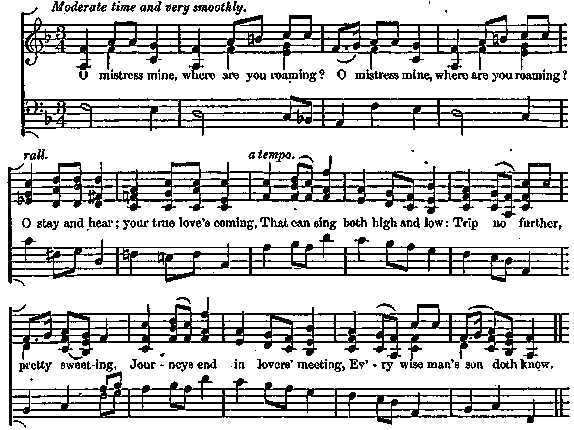Popular Music Of The Olden Time Vol 1
Ancient Songs, Ballads, & Dance Tunes, Sheet Music & Lyrics - online book
| Share page | Visit Us On FB |
|
|
||
|
ILLUSTRATING SHAKESPEARE. 209 |
||
|
|
||
|
O MISTRESS MINE!
This tune is contained in both the editions of Morley's Consort Lessons, 1599 and 1611. It is also in Queen Elizabeth's Virginal Book, arranged by Byrd.
As it is to be found in print in 1599, it proves either that Shakespeare's Twelfth ■Night was written in or before that year, or that, in accordance with the then prevailing custom, 0 Mistress mine was an old song, introduced into the play.
Mr. Payne Collier has proved Twelfth Night to have been an established favorite in February, 1602 {Annals of the Stage, i. 327), but we have no evidence of so early a date as 1599.
In act ii., sc. 3., the Clown asks, " Would you have a love-song, or a song of good life ? "
Sir Toby.—" A love-song, a love-song." |
||
|
|
||
 |
||
|
|
||
|
"What is love?—'tis not hereafter ; Present mirth hath present laughter;
What's to come is still unsure : In delay there lies no plenty; Then come kiss me, sweet-and-twenty,
Youth's a stuff will not endure."
IIEART'S-EASE. The tunc of Hearts-ease is contained in a MS. volume of lute music, of the sixteenth century, in thePublic Library, Cambridge (D. d., ii. 11), as well as in The Dancing Master, from 1650 to 1698. It belongs, in all probability, to an earlier reign than that of Elizabeth, as it was sufficiently popular about the year 1560 to have a song written to it in the interlude of Misogonus. Shakespeare thus alludes to it in Romeo and Juliet, 1597 (act iv., sc, 5.)— |
||
|
|
||